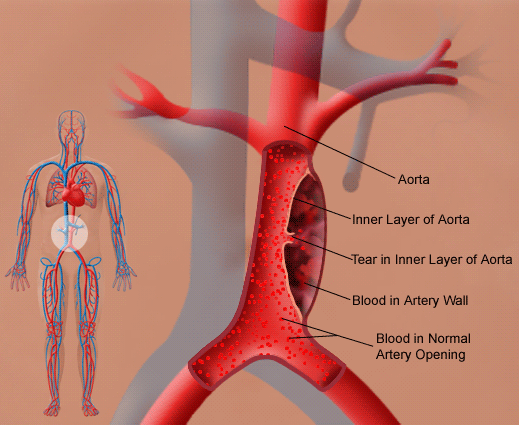aortic dissection

Aortic dissection is a potentially life-threatening condition in which there is bleeding into and along the wall of the aorta, the major artery leaving the heart. It happens most often because of a tear or damage to the inner wall of the aorta. This usually occurs in the thoracic (chest) region of the artery, but may also occur in the abdominal region.
The aorta has different branches through which blood flows. An aortic dissection is classified as type A or B depending on where it begins and ends. Type A begins in the first (ascending) part of the aorta and typically moves to another part of the chest. Type B begins in the last (descending) part of the aorta and moves down the abdomen.
When a tear occurs, it creates two channels: one in which blood continues to flow and another in which blood remains still. As the aortic dissection grows bigger, the channel with non traveling blood can get bigger as well, and push on other branches of the aorta.
An aortic dissection may also involve an aortic aneurysm – an abnormal widening or ballooning of the aorta.
The exact cause of aortic dissection is unknown, but risks include atherosclerosis (hardening of the arteries) and high blood pressure. Traumatic injury is a major cause of aortic dissection, especially blunt trauma to the chest as can be caused by hitting the steering wheel of a car during an accident.
Other risk factors and conditions associated with the development of aortic dissection including:
Aortic dissection occurs in approximately 2 out of every 10,000 people. It can affect anyone, but is most often seen in men aged 40 to 70.
Symptoms of aortic dissection
The symptoms of aortic dissection usually begin suddenly, and include severe chest pain. The pain may:
Other symptoms may include:
Tests for aortic dissection
A health care provider will take the patient's family history and listen to the heart, lungs, and abdomen with a stethoscope. A "blowing" murmur over the aorta, a heart murmur, or other abnormal sound may be heard.
There may be a difference in blood pressure between the right and left arms, or between the arms and the legs.
There may be low blood pressure, bulging neck veins, or signs resembling a heart attack. There may be signs of shock, but with normal blood pressure.
Aortic dissection or aortic aneurysm may be seen on:
Treatment
The goal of treatment is to prevent complications. Hospitalization is required.
Type A aortic dissections require surgery to repair the aorta. Type B aortic dissections may be treated with medication.
Drugs that lower blood pressure may be prescribed. These drugs may be given through a vein (intravenously). Strong pain relievers are usually needed. Heart medications such as beta blockers may reduce some of the symptoms.
Surgery to repair or replace the damaged section of aorta can cure the condition in some cases. If the aortic valve is damaged, valve replacement is necessary. If the heart arteries are involved, a coronary bypass is also performed.
Prevention
Proper treatment and control of atherosclerosis (hardening of the arteries) and high blood pressure may reduce your risk of aortic dissection. Tight control of blood pressure in patients at risk of dissection is very important. Drugs such as angiotensin receptor blockers, ACE inhibitors, and beta blockers may reduce the likelihood of dissection.
Take safety precautions to prevent injuries, which can cause dissections.
Many cases of aortic dissection cannot be prevented.


